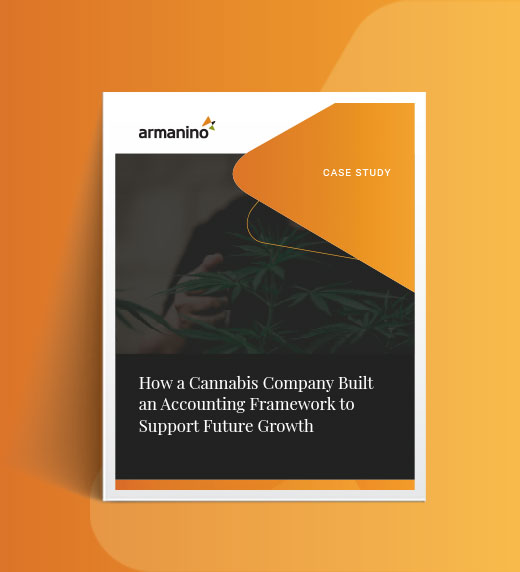
(Updated July 29, 2021)
As cannabis businesses grow beyond a few clustered locations, they’re realizing that expanding their technology capabilities is key to their future success. In addition to focusing on financial aspects such as gross margins and key KPIs for cultivation, distribution and manufacturing, business leaders need to ensure they have all this data readily available to make real-time, strategic decisions daily or weekly.
Creating an integrated technology ecosystem that provides this information is critical for successful growth. But before you begin implementing new tools, here are some key considerations to help ensure you’re adding systems that fit your current needs and put your organization in the best position going forward.
As you begin to scale, you need to start thinking about software that can help you stay in compliance with cannabis industry accounting standards and provide a holistic view of your entity. Whether you’re on the manufacturing, cultivation, distribution or dispensary side, you should track all your transactions in one place.
This process starts with selecting an appropriate seed-to-sale solution (e.g., Metrc, BioTrackTHC and Leaf Data Systems) and an accounting system, also known as a financial management system (FMS). You might require a full-blown enterprise resource planning (ERP) solution, which encompasses an accounting system/FMS plus other tools for managing your entire supply chain, logistical requirements and customer relationships.
As the core execution software for your business, seed-to-sale systems connect to any state or local reporting software. There are many platforms to choose from, offering features such as point-of-sale, procure-to-pay, warehouse management and manufacturing.
But, depending on where your company lies in the cannabis industry ecosystem, you may not need all this functionality. Look for a solution with robust capabilities in areas that align with your business model and allow you to extract the information you need and submit it to the local government entity to track the entire lifecycle of the mother plant for compliance reporting.
Being able to track and extract this information is vital, but it’s not enough. There’s also the process of filing for taxes, gaining additional investment and eventually going through a financial statement audit. That’s the purpose of an accounting system, which is critical to making sure your books and finances are in order for the appropriate accounting purposes.
Seed-to-sale software has a financial aspect but lacks the true accounting software and processes we see in typical accounting solutions. As your business grows and becomes more complex, you’ll want standardized financial statements you can report out to investors or auditors that are GAAP compliant.
Integrating your accounting and seed-to-sale systems will help give you a holistic view of the day-to-day transactions that flow to your accounting system and report out quickly and accurately so your investors can see how your organization is performing daily, weekly or monthly.
You can enhance your reporting to investors with a business intelligence (BI) tool. Information such as your actual costs may be recorded in your accounting system, while individual product revenue may be in your seed-to-sale. An effective BI tool functions like a data warehouse, providing you a single source of truth for your financial and operational data that lets you produce comprehensive reports without having to move between multiple systems.
Dashboard functionality is another asset of a BI tool. It gives your leadership team the ability to monitor the success of your business currently and over more extended periods so you can identify different margins, churns or fluctuations and quickly perform a flux analysis to locate and remedy issues.
Additionally, you may currently have or plan to implement more business technology, such as a customer relationship management (CRM) tool or a financial planning and analysis (FP&A) solution. With a solid BI tool in place, it should be easy to have the data stored in those systems feed directly into your BI tool — giving you the ability to continue to push out comprehensive reports as your business grows.
The financial health of your business will continue to be a top priority as your company scales. But you’ll also want to focus on moving away from cumbersome, Excel-based management of operations, finances and forecasts to a more automated way of getting all your information readily available to make real-time decisions.
If your data isn’t good and the numbers don’t tie together, you'll run into issues with your tax filings and financial reporting and have trouble producing insightful reports on operational performance. Only having a seed-to-sale system to compile all this information is time consuming and hinders your ability to make timely, strategic decisions that are important to the growth of your business.
That’s why having an accounting system is key because it can provide the type of accounting information you need. Likewise, a CRM can provide you the necessary tools to track customer interactions, while an FP&A solution allows your finance team to forecast more accurately.
Note that no one platform does it all. You’ll likely have to pick and choose to get the holistic view that you need. For example, a manufacturer will have different KPIs than a dispensary, so implementing tools that fit your business model will provide better insights into the performance and trajectory of your organization.
Updating your tech stack takes considerable time and effort, and we don’t recommend doing it all at once. A phased approach is best. First pick your most glaring needs, then figure out which tool will address them. Finally, decide how to implement the software.
Working with a partner that understands the cannabis industry as well as the numerous systems involved can be very helpful for this process. A good partner can help you assess and prioritize your requirements, evaluate technology options and provide implementation services to ensure your software is not only properly implemented, but done so in the order that makes the most sense.
Your top priority should be staying in compliance, which a seed-to-sale tool and accounting system can accomplish. Once you’ve tackled your most pressing issues and planned out your organization’s future state, you can begin adding more solutions as your company and challenges evolve.
If you’re implementing an accounting system, there may be integrations or customizations to work out, specific transactions you’d like to track, and account structures to give to the audit team. Similar considerations will likely have to be made when updating the other aspects of your technology stack.
You should also account for how the technology change will resonate throughout the company — employee and management buy-in is key. There will be a significant amount of training involved, so communication is critical in getting the highest adoption of a new tech stack.
The goal should be to reclaim the hours spent on training through improved efficiencies once your team has nailed down its processes in the software tool. Clear communication between all stakeholders and a well-thought-out transition plan from the current stack to the new one (e.g., what is the manual work in between, the benefits of switching, etc.) can help accelerate user adoption and improve the efficacy of your new system.
Lastly, you may want to look at adding cloud-based solutions. If your tech stack operates in the cloud, your users can have access anytime and anywhere. This allows you to do everything remotely, including all the implementations and training.
With a cloud-based tech stack, you also can ensure your team uses living documents — reducing errors from manual data entry and reconciliations. This enables your people to spend less time on tedious, repetitive tasks and more time on strategic initiatives that will help build a strong future state for your company.
To learn more about implementing a holistic tech stack that addresses your cannabis company’s specific needs, contact our cannabis experts.


